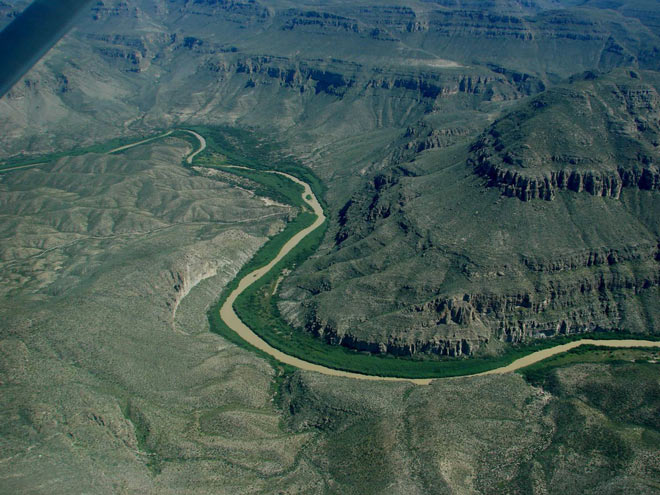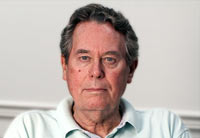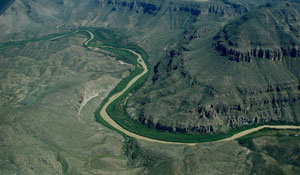An Atlanta bio-energy development company has found a way to mass-produce giant cane as a source for alternative fuels. But weed watchers in Florida are worried that the fast-growing grass could also be a dangerous invader.
BY PHIL DAQUILA

Arundo (giant cane) grows unwanted near Eagle Pass, Texas, along the Rio Grande River. Scientists in Florida worry that the plant could run amok along waterways if plant material from energy crops escapes the processing sites. (Photo by John Goolsby, USDA Agricultural Research Service.)
>> Listen to the story.Download it here.
Both the Bush and Obama administrations have pushed for an increase in the amount of energy that America produces from plants. The two plants that have provided most of the nation’s fuel in the past have been corn—for ethanol—and soybeans—for biodiesel. But scientists are looking for new options.
Giant cane, or Arundo donax, is one of those options. It grows easily and quickly—up to nearly three inches each day in the summer. That means it generates a lot of biomass, or the raw material for converting plants to usable energy products.
Biomass Gas & Electric of Norcross, Ga., is looking for energy sources among plants that can’t be used for food. And while Arundo donax can be used to make reeds for saxophones and clarinets, it isn’t used for food, and it can grow on land on which neither corn nor soybeans will grow.
Giant cane is the focus of BG&E’s efforts for several other reasons as well:
- It boasts high yield combined with low maintenance.
- It needs few agricultural inputs—only sufficient rainfall.
- It survives on low-fertility soils.
- It yields multiple harvests each year.

Michael Birch
Managing Director, AgTec Renewable Fuels, Biomass Gas & Electric
BG&E wants to grow giant cane along the Gulf Coast of Florida near Port Saint Joe. BG&E official Michael Birch says the company will generate electricity for thousands of Florida homes and businesses. It also has potential for making liquid fuels and paper pulp and even plastics some day, Birch says.
But the same characteristics of Arundo that make it a potential source of fuel also make it a potential dangerous invader of Florida’s natural environment.
The plant has been reported as invasive in Arizona, California, Georgia, Maryland, Texas and Virginia. In California and Texas, the reed has been reported to invade ditches, stream banks and lakeshores, slurping water and solar resources. Looking more like a forest than a field, dense stands of the giant cane completely suppress native vegetation. That reduces wildlife habitats, increases fire risks and interferes with flood control, botanists say.
Arundo donax has also been introduced in Florida, but it is not considered an invader—yet. In 2006, the Florida Exotic Pest Plant Council petitioned the State Department of Agriculture and Consumer Services to add Arundo to the state noxious weed list. The list is updated every two years, so a decision is expected soon.
Doria Gordon, the director of conservation science at the Nature Conservancy in Florida, has helped create an assessment tool for predicting which non-native plants may cause trouble.

Doria Gordon
Director of Conservation Science, The Nature Conservancy in Florida
“I would support Arundo’s listing as a noxious weed,” she says. “We have the science behind the prediction that would suggest that this would be a prudent decision for the state of Florida.”
Regardless of how Florida comes down on the issue, the state already requires any company wishing to cultivate energy crops there to secure a bond equal to the cost of clearing the land in the event the project is abandoned.
Meanwhile, BG&E claims it can control Arundo donax through land-management techniques.
“We don’t have any reports either in Florida or anywhere else of Arundo flying off anywhere,” Birch says. “It just doesn’t happen that way. I’m not saying it cannot happen, but we will be taking all the precautions. It is not invasive.”




